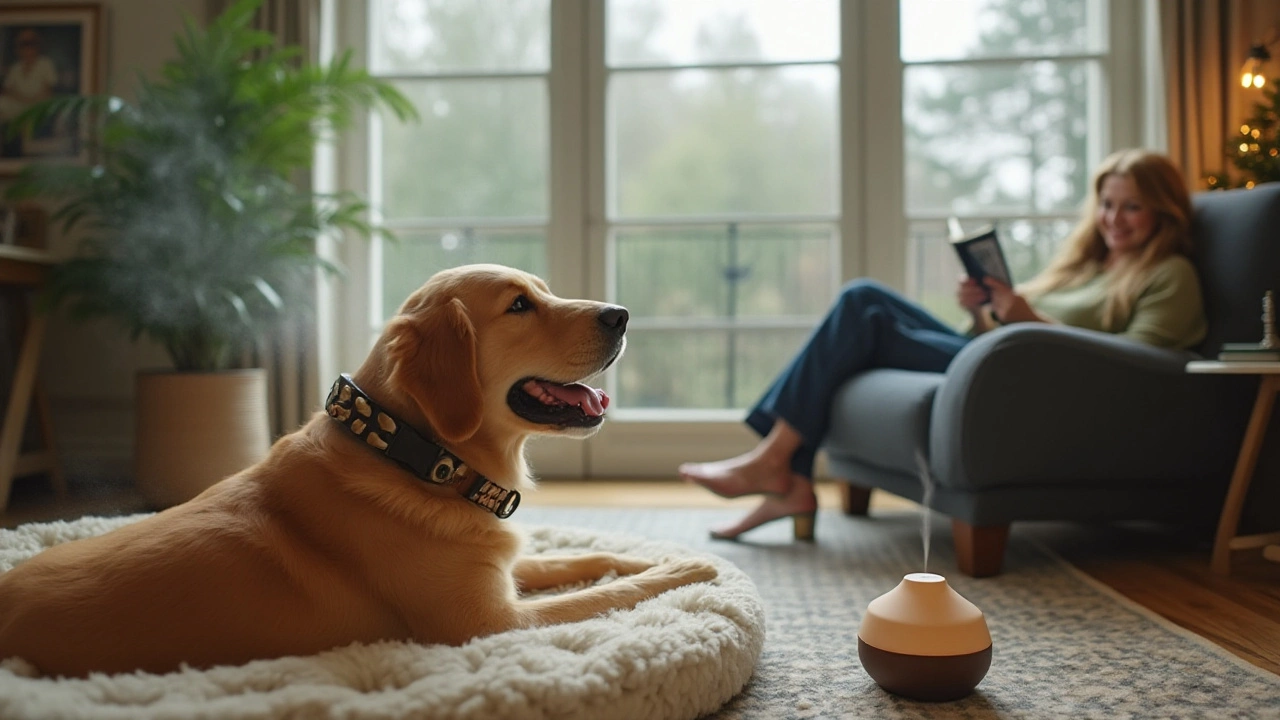Dogs, much like their human companions, can experience stress and anxiety, sometimes needing a little extra help to soothe their nerves. That's where calming collars come into play. They're designed to help ease canine anxiety through a gentle, non-invasive approach.
These collars often contain calming pheromones or essential oils aimed at reducing stress for dogs in triggering situations. Pet owners might wonder if these collars really fulfill their promise of tranquility. This article ventures into how these calming collars operate, scrutinizing their effectiveness, and offers some practical tips for pet owners seeking to find the right product for their anxious pups.
- Introduction to Calming Collars
- How Calming Collars Work
- Types of Ingredients Used
- Effectiveness and Scientific Backing
- Choosing the Right Calming Collar
- Alternative Anxiety Solutions
Introduction to Calming Collars
For many pet owners, dealing with an anxious dog can be a daunting task. An increasing number of people are turning to dog calming collars as a potential solution. These collars offer a medicinal-free approach to help ease anxiety in our beloved four-legged friends. But what exactly are calming collars, and how do they work?
Calming collars are designed to be worn around a dog's neck, similar to a regular collar. The primary purpose is to emit ingredients that are intended to promote relaxation and alleviate feelings of stress in dogs. These ingredients often include synthetic versions of natural pheromones or the gentle aroma of essential oils known for their soothing properties. Such scents can help dogs cope with anxiety-inducing scenarios like thunderstorms, trips to the vet, or loud noises.
Interestingly, pheromones used in these collars are mimics of chemicals released by a mother dog during nursing. These chemicals naturally reassure puppies that they are safe. By replicating these pheromones, calming collars aim to provide a similar sense of peace and security. This concept is backed by numerous anecdotal reports from veterinarians and pet owners alike.
"Calming collars can be an essential tool for managing mild anxiety in dogs," says Dr. Susan Wright, a licensed veterinarian with over thirty years of experience in animal behavior. "While not a cure-all, they can certainly constitute part of a comprehensive approach to anxiety treatment."
The popularity of these products is on the rise, as shown by recent sales data which indicate a growing market for pet anxiety solutions. It's estimated that the pet care industry generates about $10 billion annually in health-related products, reflecting the strong demand for such innovations. As more people embrace the idea of treating their pets' ailments naturally, the acceptance of calming collars continues to swell.
When considering a calming collar, it's vital to understand that not all dogs react the same way to these treatments. Some may benefit significantly, whereas others might show little change. This variability often depends on the dog's condition and the severity of its anxiety. Nonetheless, for many, calming collars represent a no-stress, no-mess option worth trying. They can easily complement other strategies such as behavior training and environmental adjustments.
In this section, we've taken a magnified look at what pet anxiety solutions, specifically calming collars, are about. As an accessible remedy for canine anxiety, they blend seamlessly into daily routines, requiring little to no intervention from the pet owner once in place. Here lies their real charm; their simplicity might be their most significant strength.
As this exploration unfolds, it's worth keeping in mind that while calming collars can certainly aid in soothing certain behaviors, they work best as part of a broader, mindful approach to your pet's wellbeing. In a world where stress and anxiety are just as real for pets as they are for humans, these collars offer a comforting tool to help our furry companions navigate their emotional worlds.
How Calming Collars Work
The concept behind dog calming collars is fascinating and rooted in both science and care. These collars typically harness the power of pheromones, which are chemical signals that animals, including humans, naturally emit to communicate with each other. In the wild, mother dogs release pheromones that have a calming effect on their puppies, helping them feel secure and safe. Calming collars replicate this natural process by impregnating the collar material with synthetic copies of these pheromones, often known as dog appeasing pheromones (DAP). As the dog moves around wearing the collar, body heat helps to release a continuous stream of pheromones, creating a comforting aura around the dog.
Interestingly, research has shown these pheromones may have a profound effect on adult dogs as well. One study published by the Journal of Veterinary Behavior revealed that dogs wearing pheromone-based collars showed significant reductions in stress-related behaviors in comparison to those that did not. These behaviors often include excessive barking, pacing, and inappropriate urination, which are some common symptoms of anxiety. Many pet owners notice that their furry companions seem notably more relaxed when the collar is efficiently doing its job, offering a serene environment for both the pet and the household.
Aside from pheromones, certain collars utilize essential oils known for their calming properties, such as lavender and chamomile. These ingredients are carefully chosen for their known ability to relax the nervous system. Essential oil-based collars work on the principle that olfactory senses in dogs can trigger emotional responses. The oils are slowly released, providing a consistent aromatic experience that can help soothe nervous pets without causing drowsiness. However, it's essential for pet owners to ensure that any essential oils used are non-toxic to dogs and used in appropriate concentrations to avoid adverse reactions.
"Using pheromone-based collars can offer a non-pharmacological benefit for dogs suffering from mild to moderate anxiety," notes Dr. Alice Griffin, a renowned animal behaviorist.
Additionally, it's worth noting that the effectiveness of these collars can vary significantly from one dog to another. Factors such as the dog's individual temperament, the specific anxiety triggers they experience, and the environment they're in can all impact how well a calming collar works. It's typically recommended for pet owners to observe their dogs for a significant period to genuinely ascertain the product's effectiveness, giving the collar ample time to integrate into the animal's routine.
Practical Usage and Considerations
For those interested in trying a calming collar, the application is straightforward. Most collars are adjustable and meant to be worn alongside any existing collar. It's crucial to fit the calming collar snugly but comfortably, ensuring it's neither too tight nor too loose. Regular checks will ensure the collar remains effective, as the continued release of pheromones or oils relies on maintaining contact with the dog's skin for warmth activation. However, pet owners should be aware that these collars are usually part of a larger stress management plan, which could include behavioral training or creating a more stable environment at home. Consistency and patience are key elements when attempting to ease canine anxiety with these innovative products.

Types of Ingredients Used
When discussing dog calming collars, it's important to understand the variety of ingredients utilized to soothe anxious pets effectively. These collars typically use a mix of pheromones and essential oils, both known for their calming properties. This combination can help create a sense of safety and security around dogs, making tumultuous situations a bit more bearable.
One of the primary ingredients found in many calming collars is synthetic dog appeasing pheromone (DAP). This mimics the pheromones released by nursing canine mothers to comfort their puppies, helping to reassure dogs and lessen anxiety. In some studies, DAP has shown promise in reducing stress-induced behaviors, such as barking and destructive chewing. Other collars integrate herbal blends, featuring well-known calming substances such as lavender and chamomile. Lavender, with its fragrant aroma, may have a soothing effect on the nervous system of dogs, potentially reducing restlessness.
Chamomile is another ingredient often added to calming collars. Known for its calming effects in humans, it is believed to provide similar relaxation benefits for our furry companions. The gentle nature of chamomile can contribute to a more relaxed demeanor, particularly in high-stress environments. Additionally, valerian root is sometimes included due to its sedative properties. Valerian has been used for centuries as a natural remedy for anxiety in humans and can have a comparable effect on dogs.
Dr. Sarah Ellis, a behavioral specialist, once noted, "Pheromone therapy is an invaluable tool in managing canine anxiety, offering a non-invasive and effective means of helping dogs navigate the challenges of stressful surroundings."
With all these options available, choosing the right calming collar involves considering your dog's specific needs and sensitivities. Some dogs may respond better to a particular scent or ingredient than others. It's worthwhile experimenting with different collars to find one that most positively impacts your dog's anxiety levels. Bear in mind that while some ingredients boast strong anecdotal support, their efficacy can vary from one dog to another, making it crucial to monitor your pet's reaction when first introducing the collar.
Effectiveness and Scientific Backing
Delving into the world of dog calming collars, an essential question surfaces: do they genuinely work, and what scientific backing supports their effectiveness? One intriguing aspect is the use of pheromones, which are naturally occurring chemical compounds that animals produce to communicate with each other. These compounds, when introduced artificially through collars, aim to mimic the soothing signals sent by a lactating mother dog, which in turn is expected to comfort anxious dogs.
Scientific studies examining the effectiveness of pheromone-based calming collars highlight mixed results. Some research has found that a significant number of dogs wearing these collars exhibited reduced signs of stress, particularly in scenarios with high anxiety triggers like thunderstorms or separation anxiety. A notable study published by the Journal of Veterinary Behavior tracked behavioral changes in dogs using these collars and acknowledged a statistical improvement in a fraction of cases. While not every dog responds, the success stories continue to provide hope for pet owners seeking gentle anxiety relief methods.
The Role of Essential Oils
Calming collars infused with essential oils such as lavender or chamomile also claim to offer stress-relieving properties. Essential oils have been heralded for their therapeutic benefits on humans and are believed to hold potential for pets when used correctly. However, caution and proper guidance are advised, as the sensitivity of a dog’s sense of smell dictates the concentration and type of oils utilized. Unfortunately, scientific evidence supporting essential oils specifically for canine anxiety relief is less abundant compared to pheromones. This gap leaves room for anecdotal support predominantly driving their use.
"While science is yet to solidify essential oil efficacy in pet collars, a considerable number of pet parents have witnessed tranquility in their once anxious companions," shares Dr. Aine Seavers, a respected authority in canine behavioral therapy.
Assessing the Overall Efficacy
With an array of calming collar types available, from pheromone-laden to essential oil-based, efficacy varies widely, and what works for one dog might not work for another. Owners need to keep their expectations realistic and understand these products may serve best as a supplementary measure alongside other behavioral therapies or environmental modifications. Given the variance in scientific backing, particularly the more robust evidence on pheromones compared to essential oils, these collars stand as part of a broader approach to managing pet anxiety rather than a wholesale cure. Trials and observations of the individual dog’s response remains key.
The multi-faceted nature of anxiety in pets makes it akin to a puzzle, each piece interlocking to help form a comprehensive picture of tranquility. With science gradually stepping up to the plate, dog calming collars occupy an interesting nook in this expansive field, warranting curiosity and trial among dog owners seeking to provide comfort to their four-legged friends.

Choosing the Right Calming Collar
Picking the right calming collar for your furry companion might seem like a daunting task with so many options out there, but it's truly rewarding when you start noticing a positive change in your dog’s behavior. The first step is understanding your dog’s specific needs and triggers. Is your pooch anxious around loud noises, car rides, or during visits to the vet? Knowing what causes your dog stress can guide you to the right product, as different collars target varied stressors in different ways.
Calming collars, such as the popular Adaptil dog collar, use artificial pheromones very similar to the ones that mother dogs release to calm their puppies. These pheromones are usually odorless to humans but can perform wonders on dogs' stress levels. Take a close look at the ingredients and the method of release, as it’s important that there is a consistent and adequate release for sustained calming effects. You’ll want to ensure that the dog calming collar you choose has been proven safe and effective for your dog’s breed and size, as recommendations can vary.
Consider the longevity of the collar's effects too. Some collars offer relief for a month, while others may last up to three. Your decision might depend on the frequency and duration of your dog's anxiety episodes. Also, look at reviews and perhaps seek advice from a veterinarian who might provide guidance based on clinical experience.
The American Veterinary Society of Animal Behavior suggests pheromone collars can be beneficial components in an anxiety-reduction strategy.By using such quotes, a broader understanding is provided, ensuring that your choice is well-informed.
Price can also be a factor, but remember that the most expensive collar isn’t always the best. Prioritize value over cost. Compare different brands and assess which offer warranties or the potential for refunds if the pet anxiety solutions do not meet your expectations. Some collars come with adjustable features, which are vital for both comfort and effectiveness, as a proper fit ensures steady exposure to the active ingredients. Be sure to measure your dog's neck and choose accordingly, keeping in mind that the collar should not be too tight or too loose.
If you're pondering the eco-friendly aspect, some brands focus on sustainable practices and materials. Research into manufacturers who produce hypoallergenic and eco-conscious products could be appealing if your dog has sensitive skin or you'd like to lessen your environmental impact. Combining all these factors together will help in ensuring that you provide a nurturing atmosphere, helping your dog lead a happier, stress-free life. A little bit of research can lead to optimal results for both you and your beloved pet.
Alternative Anxiety Solutions
While dog calming collars can be a valuable tool in managing pet anxiety, they are part of a larger arsenal of strategies that pet owners can adopt to help their furry friends find peace. One of the most effective alternatives is behavior modification training, which focuses on teaching dogs how to react calmly to their stress triggers. This involves a gradual process of desensitizing the dog to the source of their anxiety, such as loud noises or being left alone, through repeated exposure in a controlled manner.
Another valuable way to address pet anxiety is through environmental enrichment. Providing your dog with interactive toys, puzzle feeders, or even a playmate can help keep them engaged and mentally stimulated, reducing anxiety caused by boredom or confinement. Regular exercise is also crucial, as physical activity not only keeps your dog healthy but also releases endorphins, which are natural mood enhancers, helping to reduce stress levels. For instance, a simple game of fetch or a long walk can do wonders in calming an anxious pet.
For some pets, anxiety relief might come through dietary supplements such as Omega-3 fatty acids or specific vitamins that have been shown to aid in stress reduction. Veterinarians sometimes recommend these alongside other therapies, and it’s vital to consult a professional before starting any supplement regime. In cases where natural solutions might not suffice, prescription medications might be considered, especially for dogs with severe anxiety disorders. As always, it's essential to involve a veterinarian to discuss the best options tailored for your pet’s individual needs.
Calm-inducing pheromone diffusers or sprays can also serve as an alternative, similar to calming collars, but offering flexibility in application. These products mimic the pheromones a mother dog produces to comfort her puppies and have been shown to significantly decrease anxiety levels in many dogs. They can be used in the home environment to create a calming atmosphere for more anxious pets.
It’s prudent to remember that each dog is unique, with their personality and preference. A combination of these alternative solutions often yields the best results. As noted by Dr. Sophia Yin, a well-known veterinarian and animal behaviorist, “The key is to gradually re-educate your pet in a compassionate and patient manner, understanding their triggers and working to make them tolerable for your canine friend.”
"The key is to gradually re-educate your pet in a compassionate and patient manner, understanding their triggers and working to make them tolerable for your canine friend." — Dr. Sophia Yin
In deciding the best course of action for anxiety relief for your beloved dog, it’s always beneficial to explore and understand these alternatives thoroughly, tailoring them to fit the specific needs of your pet, ensuring a happier, less anxious life.
